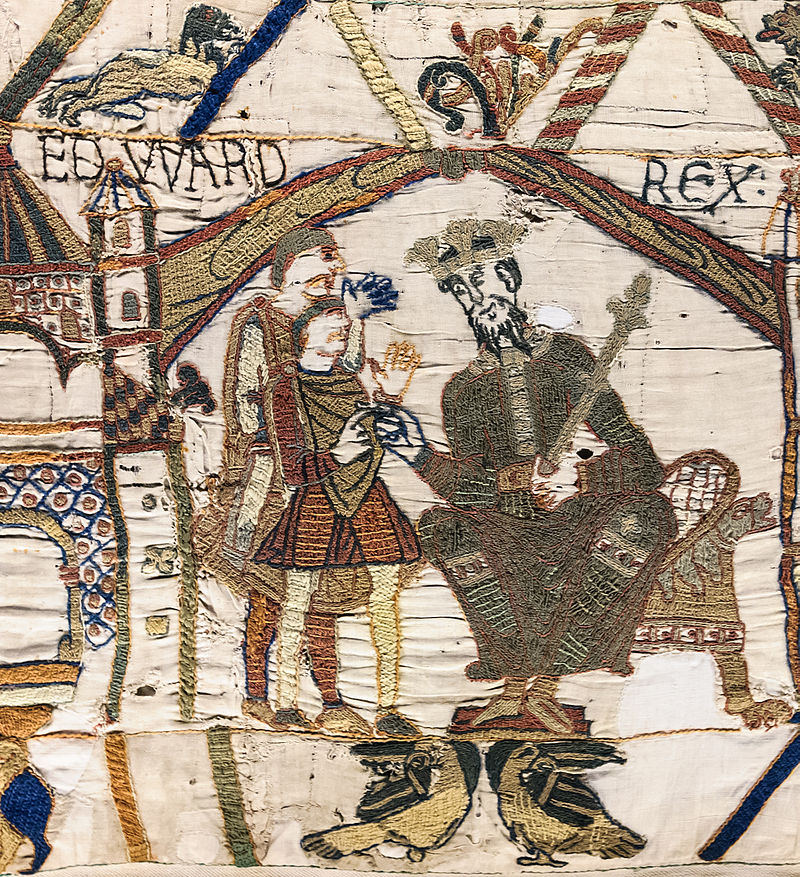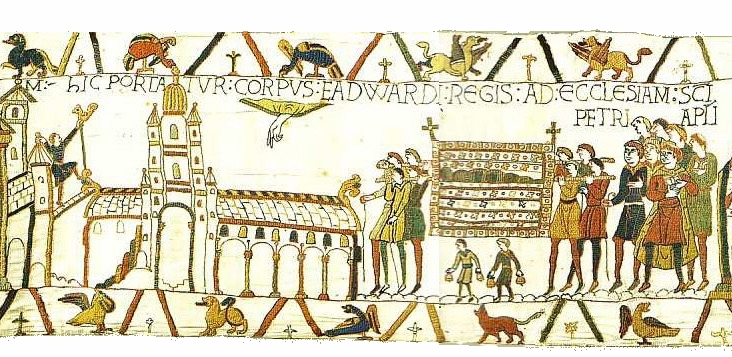by Susan Flantzer © Unofficial Royalty 2019

Saint Edward the Confessor, King of England; Credit – Wikipedia
Born between 1003 and 1005 in Islip, Oxfordshire, England, Edward the Confessor was the eldest of the three children and the elder of the two sons of Æthelred II (the Unready), King of the English, son of King Edgar I the Peaceful, and his second wife Emma of Normandy, daughter of Richard I, Duke of Normandy.

Emma with her sons Edward and Alfred; Credit – Wikipedia
Edward had two full siblings:
- Godgifu of England (1004 – circa 1047), married (1) Drogo of Mantes, Count of the Véxin, had three children (2) Eustace II, Count of Boulogne, no children
- Alfred Ætheling (circa 1005 – 1036), unmarried
Edward had ten half-siblings from his father’s first marriage to Ælfgifu of York. All of Æthelred’s sons were named after Æthelred’s predecessors. Ætheling was used in Anglo-Saxon England to designate princes of the royal dynasty who were eligible for the kingship.
- Æthelstan Ætheling (died 1014)
- Ecgberht Ætheling (died circa 1005)
- Edmund Ironside, King of the English (died 1016), married Ealdgyth, had two sons
- Eadred Ætheling (died before 1013)
- Eadwig Ætheling (died 1017)
- Edgar Ætheling (died circa 1008)
- Eadgyth, married Eadric Streona
- Ælfgifu, married Uhtred the Bold, Ealdorman of Northumbria
- Wulfhilda, married Ulfcytel Snillingr
- Name unknown, Abbess of Wherwell Abbey
Edward had two half-siblings from his mother’s second marriage to Cnut the Great, King of England, Denmark, and Norway:
- Harthacnut, King of Denmark and England (circa 1018 – 1042), unmarried
- Gunhilda of Denmark (circa 1020 – 1038), married Heinrich III, Holy Roman Emperor, had one daughter
Edward had two stepbrothers from the first marriage of his stepfather Cnut the Great, King of England, Denmark, and Norway to Ælfgifu of Northampton:
- Sweyn Cnutsson (circa 1016–1035), unmarried
- Harold Harefoot, King of England (circa 1016 – 1040), married (?) Ælfgifu, possibly had a son Ælfwine who became a monk

Emma and her sons Edward and Alfred being received by her brother Richard II, Duke of Normandy; Credit – Wikipedia
In 1013, when Edward was around ten years old, Sweyn Forkbeard, King of Denmark and Norway launched an invasion to also become King of England. As Sweyn’s forces approached southern England, Emma and her children were sent to the Isle of Wight for safety. Æthelred soon followed them to the Isle of Wight and in August 1013, he sent Emma and their children to safety in Normandy. By the end of 1013, English resistance had collapsed and Sweyn had conquered the country, became King of England, and forced Æthelred into exile in Normandy. When Sweyn Forkbeard died in 1014 and Æthelred regained power, Edward stayed on in Normandy, being raised in the court of Richard II, Duke of Normandy, his paternal uncle. He grew up favoring Norman customs, never expecting to become King of England.
Edward’s father, Æthelred II (the Unready, King of the English, died on April 23, 1016, and was succeeded by his eldest surviving son from his first marriage Edmund II (Ironside). After Æthelred’s death, Cnut the Great, son of Sweyn Forkbeard, attacked London and demanded a large sum of money for Emma’s ransom. London held out and Cnut was forced to retreat from London but he did not leave England. Edward’s half-brother Edmund fought five battles against the Danes, ending in his defeat on October 18, 1016, at the Battle of Assandun. Edmund and Cnut agreed to divide the Kingdom of England with Edmund taking Wessex and Cnut the rest. However, Edmund died on November 30, 1016, leaving two young sons. Cnut became the king of all of England and exiled the remaining members of Edmund’s family.
In 1017, Cnut thought it would be expedient to marry Æthelred’s widow and sent for Emma. It is unclear whether Emma married Cnut by force or if she chose to accept Cnut’s proposal but she returned to England and married Cnut. Her children by Æthelred remained in exile in Normandy. Cnut became King of Denmark in 1019 and King of Norway in 1028 and his territories were called the North Sea Empire.
Cnut died in 1035 and was succeeded in England by Harold Harefoot, his son from his first marriage, and in Denmark by Harthacnut, his son from his second marriage to Emma and therefore, Edward’s half-brother. In 1036, Edward and his brother Alfred returned to England from their exile in Normandy to visit their mother. As they made their way to London, they were betrayed. Alfred was blinded with a hot iron to his eyes and died soon afterward. Edward escaped the attack and returned to Normandy. It is unclear exactly who was behind the attack on Alfred. Some historians claim Harold Harefoot was behind the attack so he could rid himself of two more potential claimants to the English throne by killing Edward and Alfred. Other historians argue that Godwin, Earl of Wessex, who was traveling with Alfred and Edward as their protector, could have been the instigator of the attack.

Bayeux Tapestry – Scene 1: King Edward the Confessor, enthroned, and Harold Godwinson at Winchester; Credit – Wikipedia
When Harold Harefoot died in 1040, Edward’s half-brother Harthacnut, King of Denmark also became King of England. Harthacnut lived only two more years and upon his death in 1042, Edward became King of England. Harthacnut’s throne in Denmark was inherited by Magnus I, King of Norway. Edward’s coronation was held on Easter, April 3, 1043, at the Old Minster in Winchester, England. Upon his accession, Edward realized that his kingdom was divided between Saxons, Danes, and Norse with powerful earls from all three factions. To Edward’s credit, he succeeded in governing his kingdom despite those issues.
On January 23, 1045, Edward married Edith of Wessex, daughter of the powerful Godwin, Earl of Wessex, the father of the last Anglo-Saxon king, Harold II Godwinson, King of England, who was defeated by William II, Duke of Normandy (William the Conqueror) at the Battle of Hastings in 1066. The marriage was childless and Edward treated Edith with great respect and endowed her with valuable property all over England.
In 1051, Godwin and his sons fell out of favor with Edward and fled England. Edith was sent to a nunnery, possibly because she was childless and Edward hoped to divorce her. During the exile of Godwin’s family, William II, Duke of Normandy (William the Conqueror) visited Edward, his first cousin once removed, and apparently, Edward named William as his successor. Godwin and his family returned to England the following year with armed forces, gaining the support of the navy, townspeople, and peasants, forcing Edward to restore his earldom. Edith was reinstated as queen and in later years, she became one of Edward’s inner group of advisers. Edward’s brother-in-law Harold Godwinson handled most of the matters of government.
In 1057, Edward discovered that his nephew Edward the Exile, the son of his half-brother King Edmund II was still alive and summoned him to England as a potential successor. However, Edward the Exile died within two days of his arrival in England and the cause of his death has never been determined. Murder is a possibility, as he had many powerful enemies. His three children Edgar, Margaret, and Cristina were then raised in Edward’s court. Margaret, known as Saint Margaret of Scotland, married King Malcolm III of Scotland and their daughter Edith (later known as Matilda) married King Henry I of England, son of William the Conqueror.

Harold meeting Edward shortly before his death, depicted in scene 25 of the Bayeux Tapestry; Credit – Wikipedia
By far, Edward’s greatest achievement was the founding of Westminster Abbey which he built to atone for breaking a vow to make a pilgrimage to Rome. In 1042, he began rebuilding St. Peter’s Abbey to provide himself with a royal burial church, the first Westminster Abbey. It is possible that Edward had a series of strokes in 1065. He was too ill to attend the dedication of his greatest achievement, Westminster Abbey, on December 28, 1065. Edward the Confessor died several days later, on January 5, 1066. According to the Vita Ædwardi Regis, before Edward died he briefly regained consciousness and named Harold Godwinson as his heir. The Witan met the next day and selected Harold Godwinson to succeed Edward as King Harold II.

Edward’s funeral depicted in scene 26 of the Bayeux Tapestry; Credit – Wikipedia
Edward was buried before the high altar in his new Westminster Abbey. In 1245, the construction of the second and present church was begun by King Henry III who selected the site for his burial. King Henry III oversaw a grand ceremony on October 13, 1269, to rebury Edward the Confessor in a magnificent new shrine, personally helping to carry the body to its new resting place.
Shrine of Saint Edward the Confessor, King of England
In 1161, Pope Alexander III canonized Edward as a saint. The title “Confessor,” short for Confessor of the Faith, was given to male saints who lived a holy life and died in peace. Saint Edward the Confessor was one of England’s national saints until King Edward III adopted Saint George as the national patron saint in 1358 when the Order of the Garter was founded. Saint Edward the Confessor’s feast day is October 13 and is observed by both the Church of England and the Roman Catholic Church.
Steps leading up to Edward the Confessor’s Chapel, located on the left side of the high altar
Each October 13 – 20, Westminster Abbey observes Edwardtide which celebrates the life of Saint Edward the Confessor. On October 13, National Pilgrimage Day, everyone is welcome, without a ticket, “to visit the Abbey with other pilgrims and experience its beauty and space in an atmosphere characterised by prayer. Everyone will be able to pray at the Shrine of St Edward – the only shrine in this country that still contains the body of the saint.” On October 13, 2018, this writer had the experience of attending the National Pilgrimage Day. The Chapel of Edward the Confessor is usually not open to tourists and it was awe-inspiring to see the shrine surrounded by the tombs of kings and queens. In the photo above of the shrine, notice the three openings at the bottom of the shrine. These are openings where pilgrims enter to kneel to pray. Imagine all the people over the centuries who have knelt there.
Queen Elizabeth II placing a tribute of roses on the altar in the Chapel of St Edward the Confessor in Westminster Abbey before the service inaugurating the 12-month long commemoration of the 900th anniversary of the consecration of the Abbey on December 28, 1965
England: House of Wessex Resources at Unofficial Royalty
- Unofficial Royalty: House of Wessex Index
- Unofficial Royalty: British Royal Burial Sites: House of Wessex
- Unofficial Royalty: Coronations before the Norman Conquest (871 – 1066)
Works Cited
- Ashley, M. (1998). The Mammoth Book of British Kings & Queens. New York: Carroll & Graf Pub.
- Cannon, J. and Griffiths, R. (1988). The Oxford Illustrated History of the British Monarchy. Oxford: Oxford University Press.
- Dodson, A. (2004). The Royal Tombs of Great Britain. London: Duckworth.
- En.wikipedia.org. (2019). Edward the Confessor. [online] Available at: https://en.wikipedia.org/wiki/Edward_the_Confessor [Accessed 24 Mar. 2019].
- Flantzer, S. (2019). Emma of Normandy, Queen of England, Denmark, and Norway. [online] Unofficial Royalty. Available at: https://www.unofficialroyalty.com/emma-of-normandy-queen-of-england-denmark-and-norway/ [Accessed 28 Feb. 2019].
- Williamson, D. (1998). Brewer’s British Royalty. London: Cassell.
This article is the intellectual property of Unofficial Royalty and is NOT TO BE COPIED, EDITED, OR POSTED IN ANY FORM ON ANOTHER WEBSITE under any circumstances. It is permissible to use a link that directs to Unofficial Royalty.
